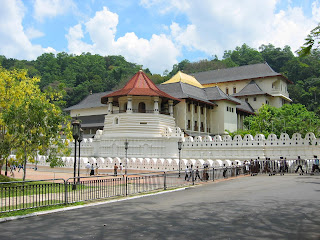This is Ruvanvelisaya, the dagoba--alias stupa, pagoda, or reliquary monument--built at the Mahavihara by King Dutthagamini in the second century B.C. after recovering Anuradhapura from a period of Indian rule. Its form is classic, with a bubble-shaped mass of millions of baked bricks, covered with plaster to prevent water damage. On top, there's a square hataraskotuva with its sides appearing to be fenced. On top there's a cyclindrical devalakotuva and a final spire, cropped here, the chattravati. This stupa was eroded to a nub by the time the British set about restoring it. Even if it's substantially a product of the 20th century it's still the most sacred of any of the dagobas at Anuradhapura. The white, by the way, is historically authentic, although dagobaswere probably trimmed with floral swags in plaster. 
Nearby are the ruins of the Lovamahapaya or the brazen palace, a monastery with a thousand rooms. It, too, was built by Dutthagamini.
Any ideas? This is about what the British saw when they came to Anuradhapura.
Under restoration when this photo was taken in 2005, it's the Abhayagira dagoba, built by Vatta Gamini about 80 B.C., shortly after another period of Indian rule. The monks at Abhayagiri were often in conflict with those at the nearby Mahavihara, partly because the monks here were less traditional--some even following Mahayana Buddhism rather than the orthodox Theravada.
Abhayagiri prospered with royal support. Here's a description from a fifth century visitor, the Chinese monk Fa-hsien (Faxian, "master of the law"):
"By the side of this stupa, a monastery was erected which is called Abhayagiri (the Hill of Fearlessness), and here are five thousand monks. It contains a hall for the worship of Buddha, engraved with gold and silver and adorned with precious stones. In it stands an image of Buddha made of green jade, some twenty feet high. The entire image sparkles with the seven precious substances, and its splendour and magnificence defy description. In its right hand, the image holds a priceless pearl."
By the time the British came, the whole thing was shrouded in scrub forest.
Unprotected by plaster, the brick weathers into rubble.
We'll return to Abhayagiri, but here is another puzzle to consider. Any ideas? Answer: it may have held cooked rice, enough for the monastery's 5,000 monks.
This is the biggest dagoba of all, the Jetavana, built by another splinter group from the Mahavihara. It was built late in the third century under King Mahasena, and the name comes fromjotivana, "the source of radiance."
The picture hints at the cardinal axiality that permeates all these monasteries. Not only are the squares that surround the dagobas oriented to the compass points, so were the streets of the surrounding monasteries, home in this case to 3,000 monks.
Jetavana is said to contain 93 million bricks and to be the largest brick structure in the world.
The solid object in the scaffolding is an elevator. The tube running down the side of the dagoba is a trash shute.
In between, there's a temporary staircase.
There's a lot more to Anuradhapura than brick mountains. Here, for example, is a pond in what has been called a royal pleasure garden.
Water came from Tissa Wewa, a nearby reservoir. The kings who built Anuradhapura were great reservoir builders, because without irrigation their kingdoms would have been vastly poorer.
Close to Abhayagiri are the Twin Ponds, Kuttam Pokuna. The walls and floors are of cut granite slabs; buried pipes both filled and drained the ponds.
Detail.
The pots are punkalas, symbols of plenty
Anuradhapura also had two much bigger ponds, only one of which has been excavated. The treatment of walls is very different.
Perhaps the reason is simply the scale of the thing. This is Eth Pokuna, called Elephant Pond.
A nearby desilting tank minimized sedimentation in the main pond.
Speaking of water, here's an old road; it's about to cross a river.
Everything is granite.
So, too, is this classic Buddhist railing at Jetavana. It may have surrounded an image house, with a statue of the Buddha, such as those that survive at Polonnurawa.
Granite, too, are the walls flanking this road near the Elephant Pond. We've about to see something special.
This is the ruin perhaps of a library, but it's called Mahasena's Palace. We're here for the half-circle stone at the bottom of the steps. It's a moonstone.
There's plenty of room for interpretation here, and nothing is certain. One reading is that the outer ring is the outer world in flame. The animals represent the cycle of rebirths. The vine represents craving, the source of unhappiness. The birds--the Indian goose, or hamsa--represent purity and the Buddha's disciples. In the middle is the divine lotus. Entering the building, in short, is an act of purification.
The inner rings.
The outer ones.
Here's the same building in glorious ruin.
And here's a second moonstone. It's at the so-called Queen's Pavilion, near the Abhayagiridagoba.
Lotus leaves in the geese's bills.
Detail.
The steps are said to represent stages of purification. The supporting dwarfs are similar to those at Sanchi (Peninsular India) and many other places.
The monks at Anuradhapura lived in complexes of a very regular design, with four buildings at the corners of a rectangle and a central building for the monk who was their teacher. Here's the entrance to the residence of a chief monk. There's a simple moonstone flanked by two handsome guardstones for protection.
Another example.
There are different guards; this one is a nagaraja, an anthropomorphized king cobra. He holds a pot of plenty, a punkala.
The monasteries were fastidious about many things. Here's one of many surviving toilets, which drained into underground pits.
The work of reconstruction goes on.
Lots more where those came from.
There's plenty to do. Here, the ignored ruins of Puliyankulama, at the northeast corner of Anuradhapura.

